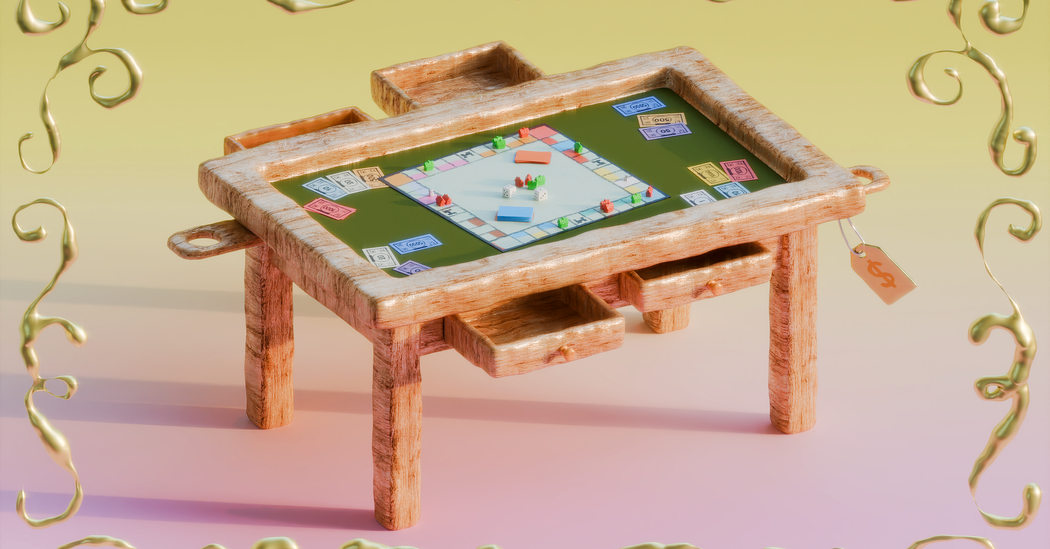Josh Derrig estimates he’s spent about $30,000 on tabletop gaming furniture. The crown jewel of the dining room in his Akron, Ohio, home is a massive 10-seat Prophecy gaming table from Wyrmwood that cost more than $10,000.
“We use it almost every day, even when we have people who have nothing to do with gaming,” Derrig, 35, said. “We use it for Easter and Thanksgiving and Christmas dinners with the family.”
Because board games have a reputation for being affordable among casual followers, the money dedicated players spend on custom furniture and accessories can be staggering. But the everyday function of these tables makes their steep prices a little more understandable. They often have removable wooden tops that cover built-in play surfaces, for example, where people can store current games for later.
For Mr Derrig, who works as an Amazon delivery driver, these tables and accessories are a worthwhile investment, like a high-end sofa or mattress, allowing his family to organize and use their extensive game collection without a dedicated games room .
That utility is why Mr. Derrig bought another table for $2,000 and later added a third. “It’s not cheap by any means, but for people in the gaming industry, we spend thousands and thousands on our board games to begin with,” he said.
Even cheaper options can rack up a bill of several hundred dollars.
Ashton Wu, 27, ordered his first tabletop gaming table on Kickstarter in 2016. Although he found the $800 price tag reasonable, he was surprised when the table finally arrived.
He reviewed the table a few years later on his YouTube channel, and the popularity of the video made it clear that viewers were curious if these tables were worth it. Since then, Mr. Wu, who lives in San Jose, California, and his YouTube co-host, Daniel Shi, have tried nearly a dozen tables, including DIY projects and tables from popular brands.
Mr. Wu noted that the physical appeal of gaming accessories enhances the experience of playing a board game. “There’s a lot of physicality to this hobby,” he said. “People really like nice components, like nice miniatures, nice-feeling cardboard, nice-feeling sleeves.”
Mr. Wu also suspects that there is a strong overlap between board game enthusiasts and do-it-yourselfers, as many games require players to craft storage solutions for game pieces.
“It’s another kind of attitude that board game players have, like, ‘Oh, I want a table?’ Okay, let me build one,” he said.
And for those who love board games, buying special furniture can be another way to enjoy it better. Michelle Sater, 44, turned the basement of her Omaha home into a game room with a few big purchases and a little creativity. Her orange-and-purple space, which she fondly calls the Board Room, has two large game tables, custom shelving and more than 1,500 games.
Although she bought one table, she made the other with a friend using a second-hand table. In all, it cost her several hundred dollars to create her dream table: a solid oak table with a purple microsuede play area, cup holders, and hinged pieces that unfold into individual player spaces. She added that the most expensive pieces of furniture in her game room are probably the $800, 14-foot long shelves she installed to store her games.
Ms. Seiter also spent hundreds of dollars on upgraded gaming accessories from Top Shelf Gamer, which she organized on another shelf so they could be used with each game. Ms. Seiter appreciates the same physicality of board games that Mr. Wu pointed out. She said these accessories are one of her favorite aspects of the hobby because she’s “a very tactile person,” and the additions allow her to “play around with pieces that are all different shapes and textures and feels and weights.”
For some, the search for gaming furniture has led to a rewarding career. Will Patton, 37, started making gaming tables in 2018 after being laid off from his job as a mechanical engineer. He sold his first table to a friend and later posted pictures of it on Facebook Marketplace to gauge interest.
When he started getting orders left and right, he founded his business, Tables 4 Games. By early 2023, he decided to quit his job and start making tables full time. He has now shipped more than 200 tables from his woodworking shop in Martinez, Georgia, to customers in 43 states.
While his typical customers can vary, he said he can usually sort them into three groups: young adults who play often with board game groups, families with children and older people who use his puzzle tables. His most popular tables range from $1,500 to $2,000, and he said he hasn’t haggled with buyers since the Facebook Marketplace days.
Mr Patten said most of his customers “do their research” before buying one of his tables. He often meets them at a convention or online, and then “a year later they’ll come back to me and then say, ‘We’re ready to pull the trigger.’ It’s not a purchase that many people will take lightly,” he said.
When it comes to upgrades, Mr. Patton’s clients tend to keep things simple. He estimated that about 20 percent of his buyers added cup holders to his tables, and 50 or 60 percent chose a harder wood than his default option, yellow pine.
Mr Patten said that while some gaming furniture was “very loud” and complex in design, his philosophy was simplicity. “I just want it to be a normal table that has this cool, extra functionality,” he said.
And for enthusiasts like Ms. Sater and Mr. Derrig, who each host playgroups at least once a week, having functional and aesthetically pleasing furniture makes all the difference.
“Everyone has their hobbies,” Mr. Derrig said, “and most people’s hobbies probably cost them money in some way that other people wouldn’t spend.”



